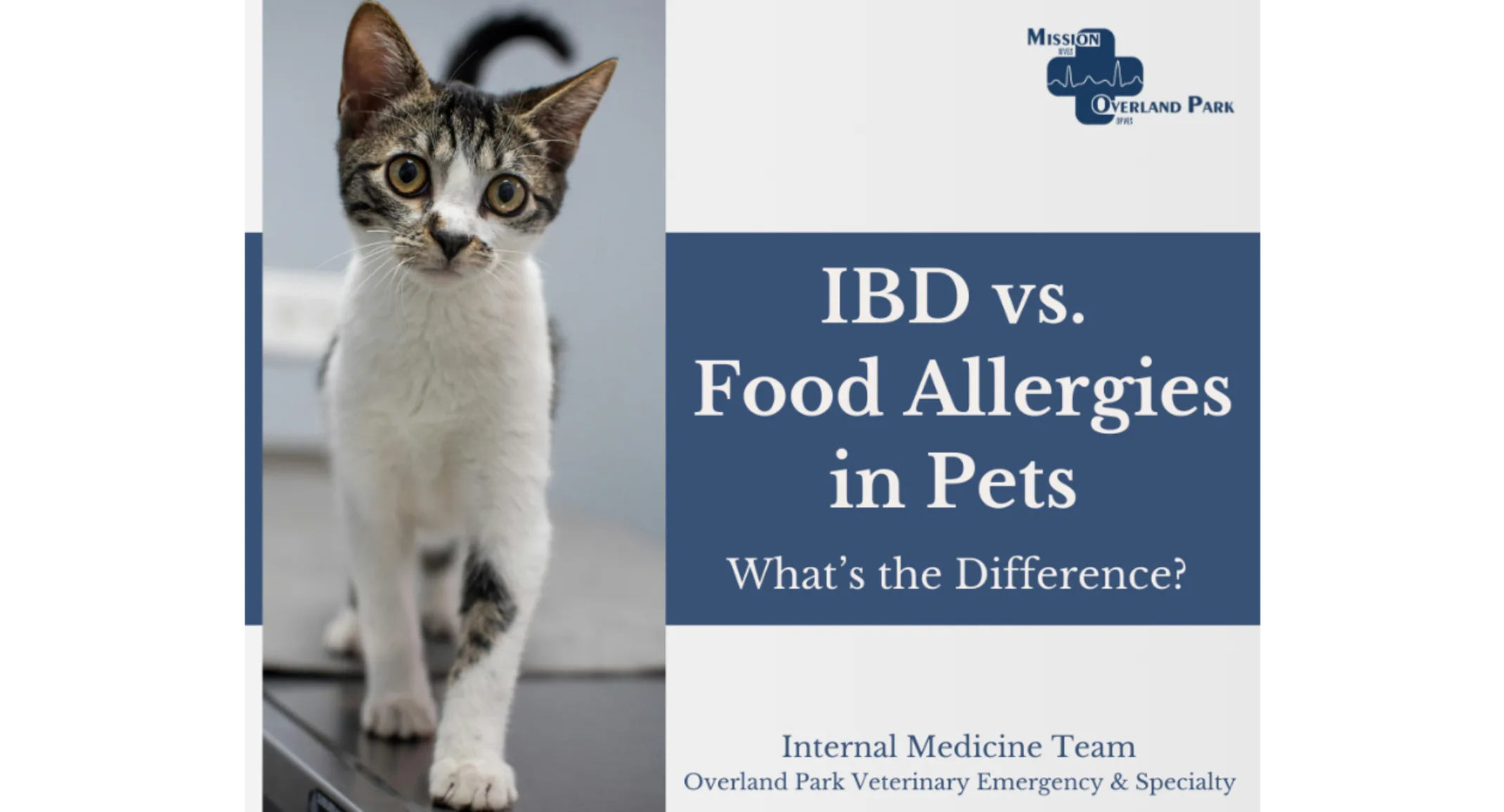IBD vs. Food Allergies in Pets: What’s the Difference?
Food Tips

Introduction
If your dog or cat is dealing with chronic vomiting, diarrhea, or other digestive issues, you're not alone. Gastrointestinal (GI) problems are among the most common reasons pet owners seek veterinary care. But determining why these issues are happening isn’t always simple.
Two of the most common culprits—Inflammatory Bowel Disease (IBD) and food allergies—can look very similar on the surface. However, they are fundamentally different conditions that require different treatment approaches. As veterinary internal medicine specialists, our job is to dig deeper and uncover the true cause behind your pet’s symptoms so we can create a targeted, effective treatment plan.
Understanding the Basics
What is IBD (Inflammatory Bowel Disease)? IBD refers to chronic inflammation within the lining of the gastrointestinal tract. This inflammation disrupts your pet’s ability to digest and absorb nutrients, leading to ongoing GI distress.
There are several forms of IBD, depending on which type of inflammatory cells are present:
Lymphocytic-plasmacytic: The most common type, particularly in cats
Eosinophilic: Often seen in allergic conditions
Granulomatous or neutrophilic: Less common but can be more severe
The exact cause isn’t always known, but many cases are thought to be immune-mediated, where the body’s immune system mistakenly attacks its own GI tissues.
What are Food Allergies?
A food allergy is an abnormal immune reaction to specific proteins in your pet’s diet—typically in ingredients like beef, chicken, dairy, or, less commonly, grains. Grain allergies are commonly misunderstood, as pets are far more likely to be allergic to a specific protein than grains. Unlike food intolerance (which may cause gas or bloating), a true food allergy triggers an immune response, often affecting both the skin and GI tract.
Clinical Signs – What Pet Owners Might Notice
IBD and food allergies can appear nearly identical in how they affect your pet. Here are some shared signs:
Vomiting
Diarrhea
Weight loss
Flatulence
Abdominal discomfort
However, there are some key clues that help us tell them apart:
Signs more common in IBD:
Long-term, chronic symptoms
Poor response to fundamental diet changes or over-the-counter medications
Potential progression despite treatment
Signs more common in food allergies:
Itchy skin
Chronic ear infections
Symptoms that improve or resolve on a strict diet trial
Diagnostic Process
Initial Workup
The first step is a comprehensive exam and history. We often begin with:
Blood work
Fecal testing
Abdominal imaging (like X-rays or ultrasound)
These tests help rule out infections, parasites, or other systemic diseases.
Elimination Diet Trials
If a food allergy is suspected, a diet trial is the gold standard for diagnosis. This involves feeding your pet either:
A novel protein diet (such as rabbit or venison your pet hasn’t eaten before)
A hydrolyzed protein diet (where proteins are broken down to reduce immune response)
The trial typically lasts 8–12 weeks, during which time no other foods, treats, or flavored medications can be given.
Advanced Testing for IBD
When symptoms persist or worsen, we may recommend:
Abdominal ultrasound to assess thickening or irregularities in the GI tract
Endoscopy and biopsies, which allow us to examine the intestinal lining and collect tissue samples
Histopathology, where a pathologist studies those tissues to identify the specific type and severity of inflammation
Treatment Strategies
For Food Allergies
Diet is the medicine—and strict compliance is essential
No treats, table scraps, or flavored chews unless cleared by your vet
Accidental exposures can cause relapses, so ongoing vigilance is important
For IBD
Treatment often involves multiple components, including:
Dietary management, which may overlap with food allergy protocols
Immunosuppressive or anti-inflammatory medications, such as prednisone or cyclosporine
B12 supplementation (if low) and probiotics to support gut health
Prognosis & Long-Term Care
Managing chronic GI disease is a journey, not a one-time fix. With the proper diagnosis and ongoing care, most pets can live happy, healthy lives.
What long-term care looks like:
Ongoing communication with your veterinarian or internal medicine specialist
Regular follow-up visits and lab work to monitor progress
Adjustments to diet or medication as your pet’s needs change
Nutritional counseling to ensure your pet is thriving
Conclusion
While IBD and food allergies can look very similar, their underlying causes—and the best way to treat them—are quite different. That’s why a thorough diagnostic process is so valuable.
If your pet has been struggling with chronic GI signs, don’t wait. The internal medicine team at [Your Hospital Name] is here to help get to the root of the problem and support your pet on the road to better health.
Are you concerned about your pet’s digestive issues? Reach out to our team today to schedule an Internal Medicine consultation.
To schedule a consultation with one of our IM specialists, call 913-361-3800.
